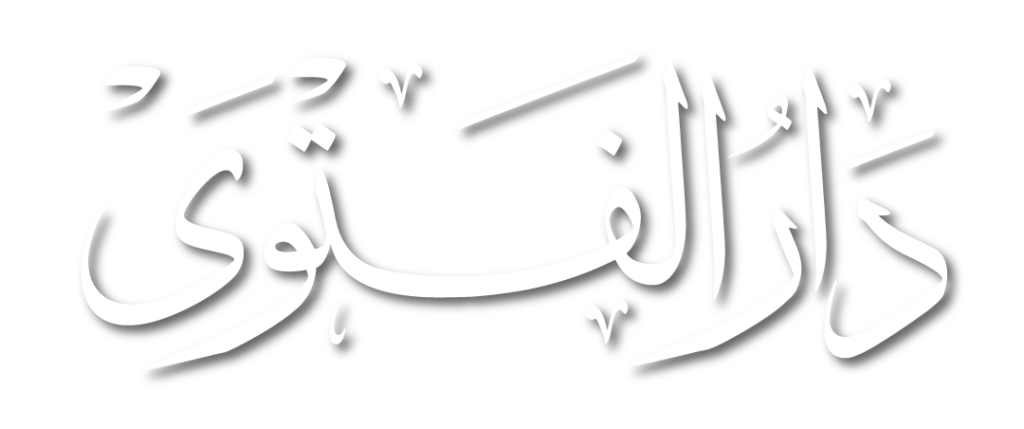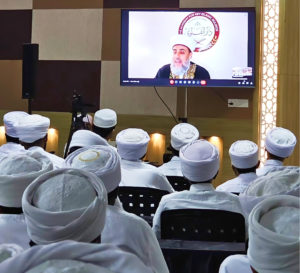INNOVATIONS: MEANING AND JUDGMENT
According to the Arabic language, the term ‘innovation’ (bid^ah), refers to any newly introduced matter, one not based on a preceding example. In the religious context, the innovation (bid^ah) is any newly introduced matter, one neither mentioned in the Qur’an nor ordered by the Prophet. Ibn ^Arabi said: “…innovations are not dispraised due to the term “innovation” or its meaning. Rather, innovations are dispraised if they contradict the rules of the Religion and if they invite to misguidance.”
There are two categories of innovations:
The Innovation of Misguidance. The innovation of misguidance is the innovation which contradicts the Qur’an and the Sunnah.
- The Innovation of Guidance. The innovation of guidance is the innovation which conforms to the Qur’an and the Sunnah.
Categorizing innovations into these two types is derived from the hadith of the Prophet narrated by al-Bukhariyy and Muslim in their Sahihs from the route of ^A’ishah in which she said: “The Messenger of Allah said:
<< مَنْ أَحْدَثَ فى أَمْرِنَا هذا مَا لَيْسَ مِنْهُ فَهُوَ رَدٌّ >>
(which means) : <<The matter innovated in our Religion which does not comply with it is judged as rejected.>>” Muslim narrated this saying of the Prophet with the following words:
<< مَنْ عَمِلَ عَمَلاً لَيْسَ عليه أَمْرُنَا فَهُوَ رَدٌّ >>
This means: <<The one who does something that does not conform to our Religion is judged as rejected.>>”
This saying of the Prophet on the one hand elucidates that it is not just any new matter in general which is judged as rejected, but rather only that new matter which does not conform to the rules of the Religion. On the other hand, it is understood if it conforms to the rules of the Religion, it is not rejected.
Likewise, the same meaning is understood from the saying of the Prophet that was narrated by Muslim in his Sahih from the route of Jarir Ibn ^Abdullah al-Bajliyy in which he said: “The Messenger of Allah said:
<< مَنْ سَنَّ فى الإسْلامِ سُنَّةً حَسَنَةً فَلَهُ أَجْرُها وَأجْرُ مَنْ عَمِلَ بها بَعْدَهُ مِنْ غير أن يَنقص من أجُورِهم شىء ومَنْ سَنَّ فى الإسْلامِ سُنَّةً سِيّئَةً كان عليه وِزْرُها وَوِزْرُ مَنْ عَمِلَ بها من بعده من غير أن ينقص من أوزارهم شىء >>
This means: <<The one who innovates a good innovation in Islam shall be rewarded for it and similarly rewarded when another imitates him in performing that deed—without the reward of the latter being decreased. And, the one who innovates a bad innovation in Islam will be sinful for it and will similarly bear a sin when another imitates him in that bad innovation—without any of the latter’s sin being lessened.>>”
In Fath al-Bari, (Ibn Hajar’s explanation of al-Bukhariyy) the Hafidh Ibn Hajar explained the statements of Ibn Shihab and ^Abdur-Rahman Ibn ^Abdul Qari as were reported by al-Bukhariyy in his Sahih, the Chapter on Tarawih Prayers. Ibn Shihab said, “At the time of the death of the Prophet, it was not the practice of the people.” (Ibn Hajar said this means the people did not pray the Tarawih Prayer in congregation.) Ibn Shihab continued to say, “The situation stayed as such during the caliphate of Abu Bakr and part of the caliphate of ^Umar.” ^Abdur-Rahman Ibn ^Abd Al-Qariyyii said, “I went out to the mosque one evening during Ramadan with ^Umar Ibn al-Khattab. We found the people praying as individuals and in small congregations. ^Umar said he saw it better if all the people would congregate behind one imam, and he congregated them behind Ubayy Ibn Ka^b. Then, on another evening during Ramadan, I went out to the mosque with ^Umar and we found the people congregating behind one imam. ^Umar said: (نعم البدعة هذه), and in the narration of Al-Muwatta’ of Imam Malik, ^Umar said: (نعمت البدعة هذه).” Both narrations contain the word bid^ah (innovation) and mean: “Indeed this is a good innovation.”
The Hafidh Ibn Hajar commented on ^Umar’s statement by saying, “The innovation is the matter which is done without a preceding example. Religiously it sometimes means a matter done against the Sunnah and as such the innovation is dispraised. However, to be more thorough, if the innovation falls under what is religiously good, then it is good. If it falls under what is religiously bad, then it is bad. Otherwise, the innovation is permissible (mubah). The innovation can also be classified according to the five judgments.” He means the judgments pertaining to the doings of the slave, i.e., obligatory, recommended, permissible, disliked, or forbidden.
Al-Bukhariyy reported in his Sahih the following saying of Rifa^ah Ibn Rafi^ az-Zarqiyy:
One day we were praying behind the Prophet. When he straightened up from ruku^ he said: سَمِعَ اللهُ لِمَنْ حَمِدَه (sami^llahu liman hamidah). A man praying behind the Prophet added: رَبَّنا ولَكَ الحَمْدُ حمدًا كثيرًا طيبًا مباركًا فيه (rabbana wa lakalhamdu hamdan kathiran tayyiban mubarakan fihi). When the Prophet terminated his prayer he inquired about the person who made the addition. When the person identified himself, the Prophet told him:
<<رأيتُ بضعةً وثلاثينً مَلَكًا يبتدرونَها أيُّهُمْ يَكْتُبُها أول>>
This means: <<I saw some (over) thirty angels rushing to write it down first.>>
The Hafidh Ibn Hajar, commenting on this report (in Fath al-Bari) said that it holds the proof that it is permissible to innovate a statement of remembrance (dhikr) during the prayer that the Prophet did not say, as long as it does not contradict what the Prophet had established.
Abu Dawud (in his Sunan) reported that ^Abdullah Ibn ^Umar used to add the wordsوَحْدَهُ لا شَرِيكَ لَهُ in reciting the Tashahhud and that he used to say, “I have added that.”
Imam an-Nawawiyy (in his book, Tahdhib Al-Asma’ Wal-Lughat) said, “Innovation in The Religious Law refers to innovating a matter that was not done at the time of the Prophet. It is divided into good and bad.
The astute Imam, Abu Muhammad ^Abdul ^Aziz Ibn ^Abdus-Salam (in Al-Qawa^id) said, “The innovation is divided into obligatory, forbidden, recommended, disliked and permissible. The way to determine the type of innovation is to measure it by the scale of the Religion. If it falls under the rules of being obligatory, then it is of the obligatory type. If it falls under the rules of being forbidden, then it is of the forbidden type. By the same analogy it would be classified as recommended, disliked, or permissible.”
Ibn ^Abidin (in “Radd Al-Muhtar) said “The innovation can be an obligatory matter such as establishing proofs to refute the factions of misguidance or learning Arabic grammar which facilitates one’s comprehension of the Qur’an and the hadith. The innovation can be a recommended matter such as establishing schools, monitoring stations and every charitable matter that did not exist at the time of the Prophet. The innovation can be a disliked matter such as ornamenting mosques. The innovation can be a permissible matter such as excessive eating and drinking and lavish clothing.”
In Rawdat at-Talibin, Imam an-Nawawiyy said about Supplication of Qunut:”This is what is reported about the Prophet and the Scholars added to it :(ولا يعز من عاديت) before (تباركت وتعاليت) and (ولك الحمد على ما قضيت استغفرك وأتوب إليك)after it. He proceeded to say, “Our companions said there is nothing wrong with this addition. Abu Hamid and al-Bandaniji and others said it is a liked addition.”
In his book “Manaqib ash-Shafi^iyy,” Imam al-Bayhaqiyy narrated the saying of ash-Shafi^iyy: “The innovated matters are of two types. One of them contradicts the book of the Qur’an, the Sunnah, the doings or sayings of the companions, or the scholarly consensus. This type is the innovation of misguidance. The other one is the innovation of goodness which does not contradict any of the aforementioned. This is an innovation which is not dispraised.”
EXAMPLES OF GOOD INNOVATIONS
- 1. The “Rahbaniyyah;” a practice innovated by the followers of Prophet ^Isa.
In Surat al-Hadid, Ayah 27 Allah said:
{وَجَعَلْنَا فِي قُلُوبِ الَّذِينَ اتَّبَعُوهُ رَأْفَةً وَرَحْمَةً وَرَهْبَانِيَّةً ابْتَدَعُوهَا مَا كَتَبْنَاهَا عَلَيْهِمْ إِلَّا ابْتِغَاءَ رِضْوَانِ اللَّهِ }
This Ayah contains the proof that there are good innovations due to that Allah praised the believing Muslims among the nation of Prophet ^Isa who correctly followed him in the matters of the belief and in clearing Allah from resembling the creation, for the Rahbaniyyah they innovated. Allah praised those followers of Prophet ^Isa because they were people of sympathy and mercy, and for innovating the practice of Rahbaniyyah, which is giving up the worldly matters to an extent that they would not marry because they desired to dedicate their lives entirely for worshipping Allah.
In Verse 27 of Surat al-Hadid, Allah established that He did not obligate Prophet ^Isa’s followers with the Rahbaniyyah, and He praised them for innovating this practice which was not ordained upon them in the Injil or in the sayings of Prophet ^Isa. Rather, this was something they innovated and chose to do to exaggerate in obedience to Allah and be accepted by Him. Those who practiced the Rahbaniyyah chose not to marry, so as not to occupy their time in providing the obligatory spending on the spouse and family members. Their living quarters were modest structures built of clay in secluded areas, and there, they dedicated all their time for worshipping Allah.
2. For the prisoner to pray two (2) rak^ahs prior to his execution by his captors—a practice first begun by Khubayb Ibn ^Adiyy (one of the best of the Companions).
In his Sahih, al-Bukhariyy narrates the story of Khubayb as follows: Ibrahim Ibn Musa told me that Hisham Ibn Yusuf told us from the route of Ibn Ma^mar from the route of az-Zuhriyy from the route of ^Amr Ibn Abu Sufyan ath-Thaqafiyy from Abu Hurayrah that he said:
The Prophet sent a delegation and assigned ^Asim Ibn Thabit as their leader. ^Asim was the grandfather of ^Asim Ibn ^Umar Ibn al-Khattab. They headed towards their destination until they reached an area between ^Usafan and Makkah. When the news of this delegation reached a group of blasphemers called Banu Lahyan, these blasphemers gathered one-hundred (100) skilled archers and followed the delegations trail intending to kill them. The Banu Lahyan troop stopped in one of the houses where they found some pits from the dates of Madinah left behind. Knowing they were on the right trail, they continued until they caught up with them.
^Asim and his men sought the protection of a nearby hill overlooking the terrain called Fadfad, but they were surrounded by the blasphemers. At that time, Bani Lahyan gave their word that they would not kill them if they would surrender. ^Asim said, “As far as I am concerned, I shall not surrender to a kafir. O Allah, inform our Prophet of that for us.” They fought until ^Asim and six others were killed by the arrows of Banu Lahyan. When Khubayb, Zayd, and a third man were the only ones left alive, the Banu Lahyan repeated their promise. Believing their word, the three Companions surrendered to them. However, as soon as they came down from their position on the hill, the men of Bani Lahyan began to tie them up using the strings from their own bows. The third companion said, “This is the first sign of betrayal,” whereupon he resisted the surrender and was killed. The Bani Lahyan took Khubayb and Zayd and sold them in Makkah.
The blasphemers of the tribe of Harith Ibn ^Amir Ibn Nawfal bought Khubayb, because Khubayb was the one who had killed Harith during the Battle of Badr. He remained their prisoner for a time until they decided to execute him. At that time he asked to borrow a razor blade from one of the women of the tribe so he could shave. She lent him a blade. This same woman, who later on became Muslim, reported: “I was not paying attention, and one of my sons went to our prisoner, Khubayb, and sat in his lap. I jumped, terrified, knowing that I had lent him a razor blade. Khubayb read the fear on my face and said, “Are you afraid that I might kill him? God willing, I shall not.” In telling about Khubayb, this woman said, “I have not seen any prisoner of war better than Khubayb. I observed him, though he was chained in iron, eating grapes at a time when the whole of Makkah did not have a single grape. It was surely a sustenance given to him from Allah.”
When they took Khubayb to the place of his execution he said, “Let me pray two (2) rak^ahs, and he did. Then he told them, “I would have prayed more had it not been the case that you would think I am stalling my execution out of fear of death.” Then Khubayb authored several verses of poetry:
فلستُ ابالى حين اقتل مسلما
على اى شق كان فى الله مصرعى
وذلك فى ذات الإله وإن يشأ
يبارك على أوصال شِلو ممزع
This mean: “If I get killed as a Muslim for the sake of Allah, I shall not care on which of my sides I receive the fatal strike. If Allah wills, He shall bless me even if my body was torn apart in pieces.” ^Uqbah Ibn al-Harith killed Khubayb.
The tribe of Quraysh had sent some people to where ^Asim had fallen to bring a part of his body to them, by which they could identify him and confirm his demise. They wanted to make sure ^Asim was dead because he had killed one of their prominent men during the Battle of Badr. Allah, however, protected ^Asim’s body from the people of Quraysh, and they were not able to obtain any part of his body.
3. The addition of writing dots on certain letters of the Arabic alphabet to easily differentiate them from other similarly shaped letters in the Book of the Qur’an—an innovation of Yahya Ibn Ya^mar.
One of the very good innovations is the addition of dots to distinguish certain letters from others in the written Book of the Qur’an. This good innovation was introduced by Yahya Ibn Ya^mar. The Companions who had first written down the verses of the Qur’an that were revealed to the Prophet wrote the Arabic letters like the ba’ (ب), ta’ (ت), and the like without the dots. Likewise written without dots on the Arabic letters were the six books of the Qur’an that ^Uthman Ibn ^Affan ordered to be written and distributed to the different countries including Basra, Makkah, and others. The copy that was left with ^Uthman was even without dots.
Yahya Ibn Ya^mar, who was the first to introduce the dots to the letters of the Qur’an, was among the followers of the Companions (tabi^in) and was a man of knowledge, merit, and piety. Ibn Abu Dawud as-Sajastani narrated in his book, Al-Masahif: “^Abdullah told us that Muhammad Ibn ^Abdullah al-Makhzumi told us that Ahmad Ibn Nasr Ibn Malik told us that al-Husayn Ibn al-Walid told us from the route of Harun Ibn Musa that he said: ‘The first to introduce the dots to the letters of the Mushafs was Yahya Ibn Ya^mar’.” When Yahya initiated this innovation, the scholars did not denounce his innovation even though the Prophet had not ordered the dots to be added.[i]
4. Calling a second adhan (call to prayer) for the Friday Prayer—an innovation of ^Uthman Ibn ^Affan, may Allah raise his rank.
In his Sahih, al-Bukhariyy reported: “Adam told us that Ibn Abu Dhi’b told us from the route of az-Zuhirryy from the route of Assa’ib Ibn Yazid that during the Prophet’s time and the caliphates of Abu Bakr and ^Umar, the call for the Friday Prayer (adhan) used to be performed when the imam sat on the pulpit. During the caliphate of ^Uthman, when the Muslim population grew larger, ^Uthman enforced a third call on the region of az-Zawra’ in Madinah.” In his book, Fath Al-Bari, Ibn Hajar reported the narration of Waki^ from the route of Abu Dhi’b: “At the time of the Prophet and the caliphates of Abu Bakr and ^Umar , the adhan on Friday used to be two (2) calls.” Ibn Khuzaymah said the two calls mentioned refer to the usual adhan and iqamah. Ibn Hajar then explained the saying that ^Uthman enforced a third call, that is, an adhan added after the usual adhan and iqamah. It may also be called a first adhan in that it was added before the usual adhan and iqamah. Also it may be called a second adhan in that it followed the usual adhan as in the narration of ^Aqil.
5. The Innovation of Celebrating the Birth of the Prophet.
An entire chapter in this book is devoted to this subject. See pages 24-29.
6. The muezzin (caller of adhan), calling salah on the Prophet after calling the adhan.
The innovation of saying aloud:” as-salah ^alan-nabiyy” after the adhan– by the muezzin– was initiated after the year 700 AH; Prior to that it was not called out aloud.
7. Writing sallallahu ^alayhi wa sallam ( صلى الله عليه و سلم) after writing the name of the Prophet.
This practice is widely spread among the Muslims and can be found in literally every authored religious work, yet this was not a practice that the Prophet himself did. The letters that the Prophet sent to kings and leaders were addressed, “From Muhammad, the Messenger of Allah, to so and so…”
8. The Sufi Orders (Tariqas).
Among the good innovations are the Sufi Orders started by pious, religious people including The Rifa^iyy Order, the Qadiri Order, and about forty (40) other orders—which are all, in essence, good innovations. The unfortunate fact that some of those who attribute themselves to these orders have actually deviated from them has no bearing on the authenticity and goodness of these orders as originally founded.
EXAMPLES OF BAD INNOVATIONS
There are two categories of bad innovations, one pertaining to the creed and one related to the practice.
A. INNOVATIONS OF MISGUIDANCE RELATED TO THE CREED
The bad innovations that contradict the creed of the Prophet and the Companions are numerous. Examples of such innovations of misguidance are:
1. Denouncing the attribute of Destining of Allah—an innovation of the Qadariyyah.
Ma^bad al-Jahniyy, in Basrah, was the first to innovate this horrendous innovation of misguidance, as was reported by Imam Muslim in his Sahih from the route of Yahya Ibn Ya^mar. Those who followed in this misguidance are called the Qadariyyah. They claim that Allah neither decrees nor creates the voluntary actions of the slaves but rather it is the slave himself who creates his own voluntary actions. Some of them claim that Allah decreed and created goodness but not evil. Other examples of their misguidance is their claim that the enormous sinner is neither a believer nor a kafir—rather he is in a state in between those two– and will be in Hellfire forever. Moreover, they deny the fact that some Muslim sinners shall be granted the intercession as well as denying the fact that Allah will be seen in the Hereafter by the People of Paradise.
2. Claiming the slave does not have a will—the innovation of the Jahmiyyah.
The Jahmiyyah are the followers of Jahm Ibn Safwan. Another name for them is al-Jabriyyah. They claim the slave is compelled in his doings and has no choice whatsoever in what he does. Rather, they say he is like a feather floating in the air which has no choice in its own direction— it moves left or right depending on whichever way the wind blows.
3. Claiming as kafir the Muslim who commits enormous sins—the innovation of the Khawarij.
The Khawarij are a group who revolted and went against the rightly guided caliph, Imam ^Aliyy Ibn Abi Talib. They claim the Muslim who commits an enormous sin blasphemes by that.
4. Claiming that there is no beginning to the creation, i.e., claiming that the universe—like Allah—exists without a beginning.
Such a claim contradicts the judgment of the sound mind and the explicit reliable religious texts.
B. INNOVATIONS OF MISGUIDANCE RELATED TO PRACTICE
Innovations of misguidance pertaining to practice that contradict the methodology of the Prophet and the Companions and contradict the rules of the Religion are numerous. Examples of such innovations of misguidance are:
1. Writing the letter sad (ص) when writing the name of the Prophet. What is even worse is writing (SAW) (صلعم).
2. Performing Dry Ablution (tayammum) using carpets and pillows that do not contain purifying dust.
3. Perverting the name of Allah when making dhikr, as do many of those who claim to be following Sufi orders.
Some pervert the name Allah to Allh with leaving out the alif of the madd (the extension represented in a). Some omit the ha’ ه) ) and say ‘alla’اللا) ). Some even say Aah, which the linguists unanimously agree is a term used as an expression of pain and ailment. Al-Khalil Ibn Ahmad said it is not permissible to eliminate the (alif of madd) (a) from the term Allah.
Explanation of the Hadith of the Prophet Narrated by Abu Dawud from the ٌroute of al-^Irbad Ibn Sariyah
The Prophet, sallallahu ^alayhi wa sallam, said:
<<وَ إِيَّاكُم وَمُحدَثَات الأمور فإن كل محدثة بدعة وكل بدعة ضلالة>>
The terminology of this hadith, in particular the term kul كل) ) is known as ^am ( عام ) (general) that has a makhsus (مخصوص) (specific) meaning. Classifying the term kul(كل) in this hadith as ^am/makhsus is determined from the previously mentioned hadiths of the Prophet that established two types of innovations, the good and the bad. Thus, the meaning of the hadith of the Prophet narrated by Abu Dawud from the route of al-^Irbad Ibn Sariyah is: <<Beware of the innovated matters, because most of them are of the bad type, and every such innovation is an innovation of misguidance.>>
Imam an-Nawawiyy in his explanation of Sahih Muslim said with regards to this hadith, the saying of the Prophet:
<<وكل بدعة ضلالة>>
is of the ^am/makhsus type and it means ‘most of the innovations’.” Then, an-Nawawiyy divided the innovations into five (5) divisions obligatory, recommended, forbidden, disliked, and permissible. This categorization was mentioned by Shaykh ^Abdul ^Aziz Ibn ^Abd as-Salam in some details in the end of the book, Al-Qawa^id. The Hafidh Ibn Hajar copied that from him in his book, Al-Fath.
An-Nawawiyy proceeded to give examples of the ^am/makhsus and cited the saying of ^Umar “نعمت البدعة هذه”, (What a good innovation this is). He stressed that although the term kul (كل) is general (^am), it can be specific (makhsus) as in the saying of Allah in Surat al-Ahqaf, Ayah 25: { تدمر كل شىء } in reference to the wind that Allah sent as a punishment to the people of ^Ad to destroy them. Literally the ayah has the general (^am) meaning of: [The wind destroys everything]. However, the intended meaning is specific (makhsus) and it is: [The wind destroys most of the things].
Likewise, the term kul (كل) in the hadith of the Prophet << وكل عين زانية >> that was narrated by Ibn Hibban and others is an ^am/makhsus. The meaning of the hadith is that most of the people look an unlawful look that invites to adultery. Definitely it is known that the prophets are impeccable from such abjectness, and kul (كل) in the hadith does not include them.
In summary the ^am/makhsus is a known technique used in the Qur’an and the hadith and is recognized by the reputable and qualified scholars. Under this methodology, although the term used is all-inclusive—to reflect the exaggeration intended by the term—it is restricted to a specific meaning.
In Ayah 25 of Surat al-Ahqaf the term kul (كل) is literally all-inclusive which would mean that the wind destroyed everything. However, the intended meaning is to reflect its overwhelming effect in that the wind destroyed the people of ^Ad, their belongings, and most of the things that came in its way.
Likewise, in the hadith of the Prophet << وكل عين زانية >> kul (كل) is literally all‑inclusive which would mean that everyone looks the unlawful look. However, the intended meaning is to reflect the overwhelming reality that most of the people—clearing the prophets, some of the highly righteous whom Allah protected and those born blind until death—look the unlawful look that invites to adultery.
The hadith of the Prophet << وكل بدعة ضلالة >> falls under the same methodology. Kul (كل) if used literally includes every innovation. However, the intended meaning is to reflect the exaggeration in that most of the innovations are of the bad kind.
The true meaning of this hadith elucidates that this hadith of the Prophet does not conflict in meaning with the other sahih hadiths of the Prophet (previously mentioned) nor with the ayahs of the Qur’an that establish the existence of good innovations.





